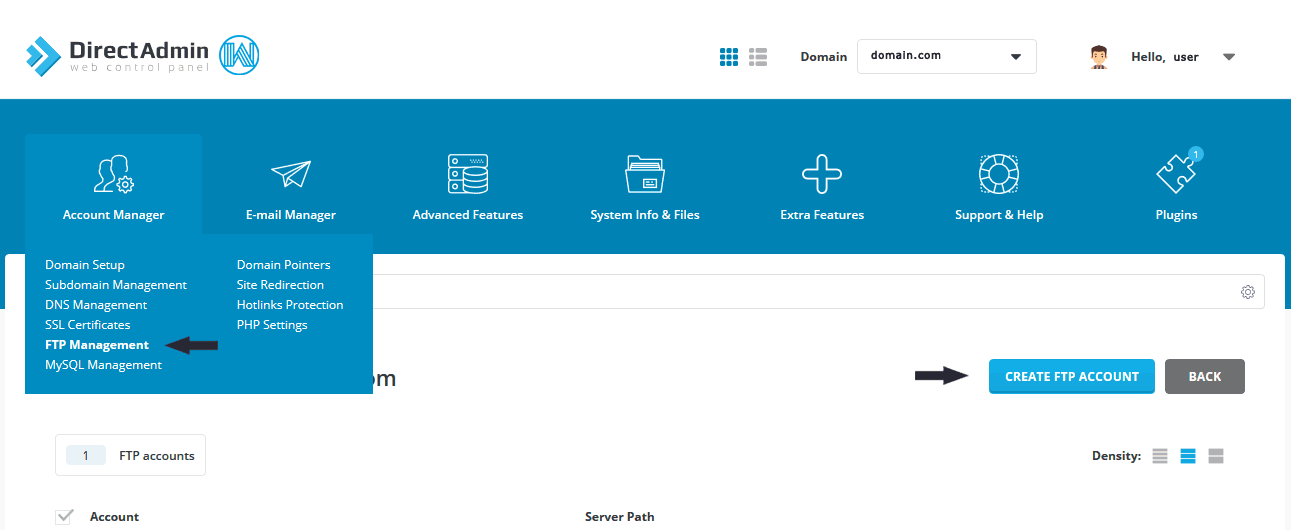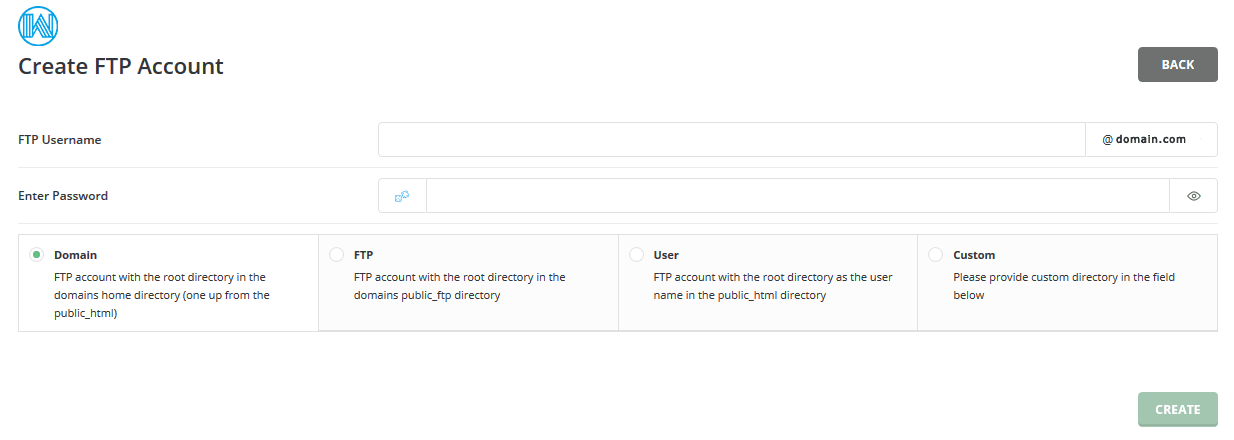Creating FTP Accounts
To create an FTP account, first click on the "FTP Managment" link under the "Account Manager tab and then click on the "Create FTP Accoount" on the right hand side of the screen:

On the following screen, you have the ability to enter your FTP credentials and you can provide an optional path to limit access of the FTP user to a certain folder:

First, select a FTP username. Next, enter a password. Then, select the access level of the FTP account.
- Domain: This FTP user has access to
public_html,private_html,mail,domains, andbackupdirectories. - FTP: This FTP user has access to the
public_ftpdirectory only. - User: This FTP user has access to
public_html/username/only. If the FTP user would only have access to public_html/username/ or http://www.woktron.com/username/, any subdomain named username.woktron.com would be accessible to this user as well.
If the directory doesn't already exist, it will be created at this stage.
Finally, click the "Create" button.
Enhanced theme (legacy)
To create an FTP account, first click on the "FTP Menu" icon in the main control panel screen. You will see a list of current FTP accounts that looks something like this:

Default FTP Account
The default FTP account and control panel account have the same login name and password. You cannot delete the default FTP account but you can make its password different from your control panel password.
Important: If you change your control panel password, the default FTP account password will still have the old control panel password. You must update the default FTP account in the FTP menu if you want both passwords to match.
Creating a New Account
Click the "Create FTP account" link. You will see a screen that looks like:

First, select a FTP username. In the above example, we chose "gary." Next, enter a password. Then, select the access level of the FTP account.
- Domain: This FTP user has access to public_html, private_html, mail, domains, and backup directories.
- FTP: This FTP user has access to the
public_ftpdirectory only. - User: This FTP user has access to
public_html/username/only. If we selected this option in the above picture, the FTP user would only have access to public_html/test/ or http://www.woktron.com/test/ (If there is a subdomain named test.woktron.com, this FTP user would also have access to it.
If the directory doesn't already exist, it will be created at this stage.
Finally, click the "Create" button.
After you click "Create," the control panel will show you the login information for the FTP account you just created. You may notice that your FTP username has @yourdomain.com after it. This is because your domain is using a shared IP address. If your web site has its own dedicated (static) IP address, your FTP username will not have @yourdomain.com after it.
If you have a dedicated IP address and you create additional domains on that account, these additional domains will have FTP logins of username@thatdomain.com.
Logging into an FTP Account
Step 1: Obtain FTP client software.
Uploading to the server through FTP requires special software. Most computer systems do not come with FTP clients, so you will have to download one from the Internet.
More information about FTP clients can be found in this guide.
Step 2: Connect to the server.
All FTP clients need the following information:
- Username
- Password
- Address - This is the address of the server. Use
ftp.yourdomain.com - Port - Use the default
port 21 - encryption - choose plain FTP or
explicit FTP over TLS( Preferred as this encrypts your data)
Some clients may ask for the host type (select "auto"), ASCII/Binary/Auto (select "auto), and the initial remote folder (you may leave this blank or change it to /domains/yourdomain.com/public_html to start off in the main web directory).
Step 3: Change to the desired directory and upload your files.
To upload, highlight the files/folders on your computer and drag them into the appropriate directory on the remote server. Each FTP client operates differently, so please consult its help file for complete instructions.
Modifying / Deleting FTP Accounts
Modifying Accounts
At the main FTP menu is a list of all FTP accounts. Click the "change" link next to the account you wish to alter. You must enter a password twice, and this password can be your old password or a new one. You may also change the access level of the account (see above). To change the password for the main username (eg: sitehelp), it's linked with your main DirectAdmin login/password, so you only need to change your DirectAdmin password to change the ftp password for that 1 account.
Deleting Accounts
To delete an account, place a checkbox next to the account you wish to delete and then click the "Delete Selected" button, as pictured here:

Note: The FTP directory itself will not be deleted unless it is empty.
Creating FTP Users for Subdomains
To restrict an FTP account to a single subdomain, follow these steps:
1. Create the subdomain if you haven't done so already.
2. From the main control panel menu, click the "FTP Menu" icon and then the "Create FTP account link."

3. In the FTP Username field, enter the subdomain name (without .yourdomain.com).
4. Enter a password in the password fields.
5. Select the User radio button.
6. Click the Create button.
Need more help?
Please contact Woktron support, or visit the DirectAdmin support forum at http://www.directadmin.com/forum.



